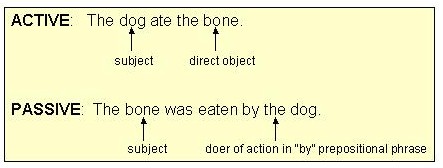
The basic sentence patterns in the English language may be transformed in the following ways:
1. Transform to passive voice
This transformation requires using a
sentence with an action verb and a direct
object.
The sentence may be any of the following patterns:
NP1 + V-tr +
NP2 The dog ate the bone.
NP1 + V-tr + NP2 + NP3
Joe gave Mary a ring.
NP1 + V-tr + NP2 + Adj We
consider Joe intelligent.
NP1 + V-tr + NP2 + NP2
The people made Olaf king.
To create the transformation,
1. make the
direct object into the subject,
2. add the
"be" auxiliary and the -en ending to the main verb, and
3. place the original doer of
the action into a prepositional phrase beginning with by.
Examples

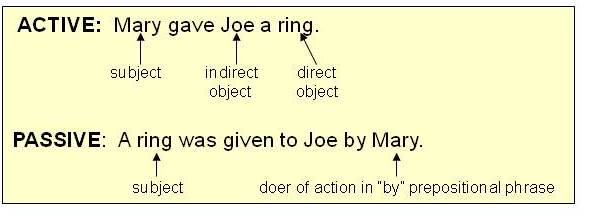
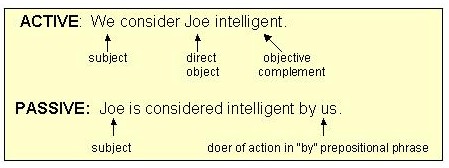
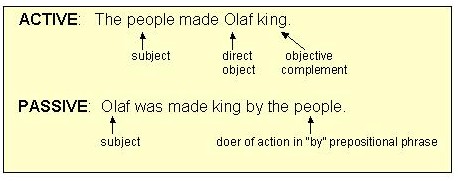
NOTE: Do not change verb tense when transforming sentences from active to passive.
ate = was eaten gave = was given consider = is considered made = was made
2. Transform to the expletive there is / there are
This transformation requires using a
sentence with a verb of being as the main verb.
The sentence pattern must be
NP1 + V-be +
ADV/TP. A fly is on the wall.
Two dogs were at the park.
To create the transformation,
1.
place there at the beginning of the sentence and
2. reverse positions of
the subject and verb.
Examples
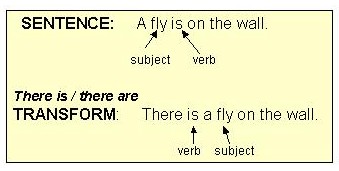
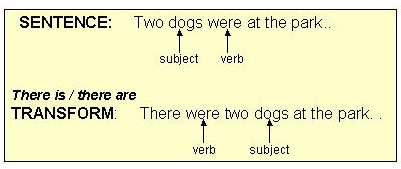
NOTE: Do not change verb
tense when creating the there is / there are transformation.
is = there is were = there were
3. Transform to cleft
This transformation allows the writer to emphasize a the sentence subject or object.
This transformation may be used with any of the sentence patterns.
There are two ways to create this transformation.
Method #1
1. Begin
the sentence with It and the appropriate number and tense of the
verb of being,
2. focus on either the
subject or direct object, and
3. create a second half
for the sentence that begins with who, whom, or that.
Examples
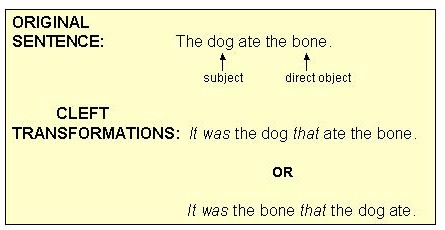
In the above
example, the first cleft transformation emphasizes the subject, dog, using three
words to refer to the dog: it, dog, and that.
The second cleft transformation
emphasizes the direct object, bone, using three words to refer to the bone: it,
bone, and that.
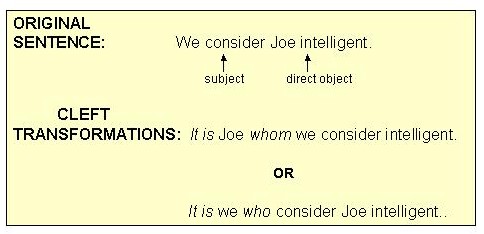
In the
above example, the first cleft transformation emphasizes the direct
object, Joe, using three
words to refer to Joe: it, Joe, and whom.
The second cleft transformation
emphasizes the subject we, using three words to refer to us it, we,
and who.
Method #2
1. Begin
the sentence with What,
2. follow with the
subject and verb, and
3. insert the appropriate tense
of the verb of being and follow with the direct object.
Examples
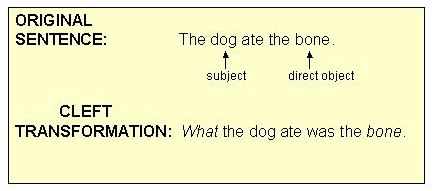
In the above example, the cleft transformation emphasizes the direct object, bone, using two words to refer to bone: what and bone.
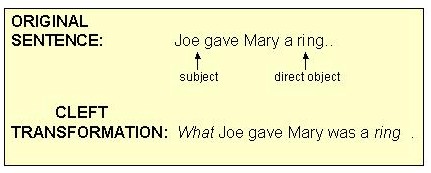
This cleft transformation emphasizes the direct object, ring, , using two words to refer to the ring: what and ring.
NOTE: Do not change verb tense when creating the cleft transformation.
PAST TENSE:
The dog ate the bone.
It was
the dog who ate the bone.
It was
the bone that the dog ate.
What the dog ate
was the bone.
PRESENT TENSE: We
consider Joe intelligent.
It is Joe
whom we consider intelligent.
PAST TENSE: Joe gave
Mary a ring.
What Joe gave
Mary was a ring.
4. Transform to negative
This transformation may be used with any of the sentence patterns.
To create the negative transformation
A. with a verb of being as the main verb: Add not to the verb.
Example
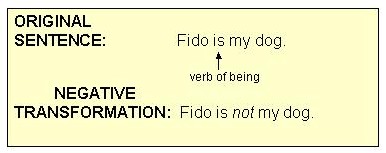
B. with an action or linking verb that has an auxiliary verb (have or be): Add not to the verb
Example - action verb
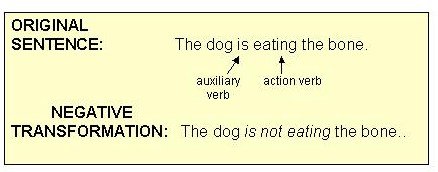
Example - linking verb
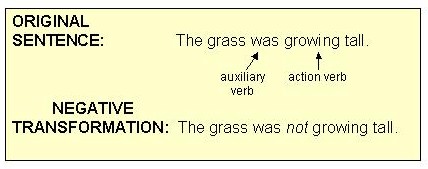
C. with an action or linking verb that
does not have an auxiliary verb: Add not and the
appropriate number and tense of do.
Example - action verb
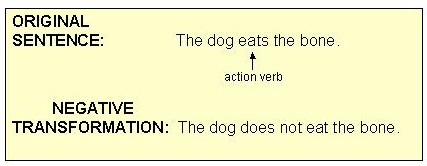
Example - linking verb
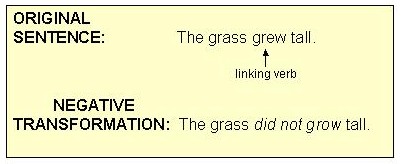
5. Transform to interrogative with yes-no answer
This transformation may be used with any of the sentence patterns.
To transform sentences into the interrogative with yes-no answer,
A. with a verb of being as the main verb: Transpose the position of the subject and the verb
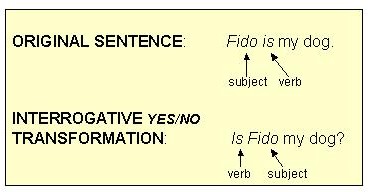
B. with an action or linking verb that has an auxiliary verb (have or
be): Transpose the
position of the subject and the auxiliary verb
Example - action verb
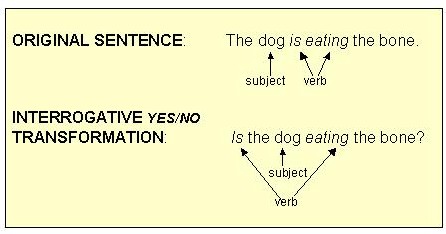
Example - linking verb
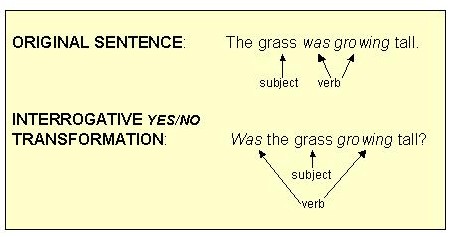
C..
with an action or linking verb that does not have an auxiliary verb: Add the appropriate
number and tense of do
Example - Action verb
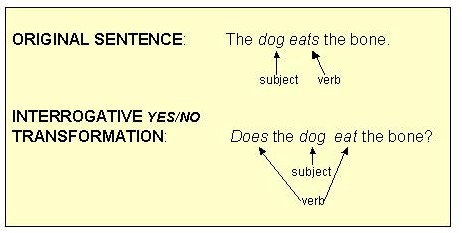
Example - Linking verb
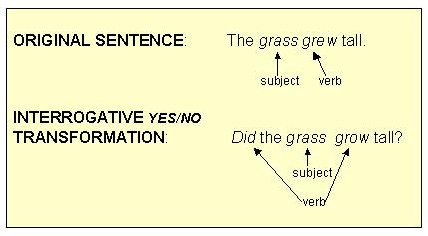
6. Transform to interrogative
This
transformation provides questions that will produce more than a yes/no
answer.
It may be used with any of the
sentence patterns.
To create the transformation,
1.
place an interrogative word at the beginning of the sentence,
2. reverse positions of
the subject and verb, and
3. add do/does/did
if needed (action or linking verb without auxiliary verb).
Interrogative words:
how when where why what which who whom
Example - verb of being
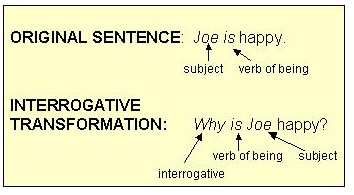
Example - action verb with auxiliary verb
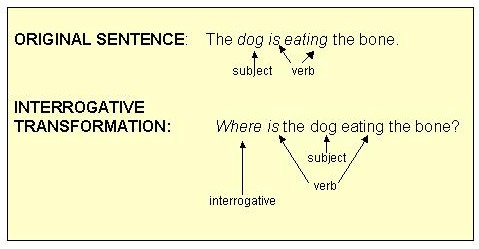
Example - linking verb with auxiliary verb
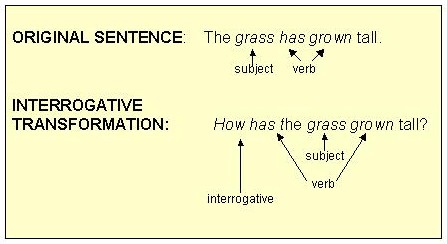
Example - action verb without auxiliary verb
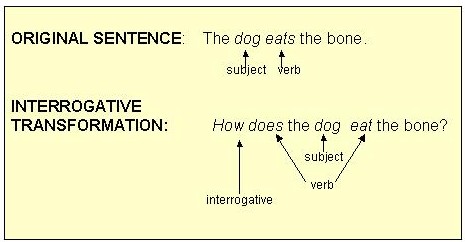
Example - linking verb without auxiliary verb

NOTE:
Sentences using which or whose to create the interrogative may not
require
adding do/does/did or transposing the positions of the subject and verb.

7. Transform to emphasis / emphatic
This transformation may be used
To make the emphatic
transformation, place do, does, or did in front of the verb, as
tense and
number dictate.
Examples

8. Transform to imperative
This
transformation creates a command.
It may be used with all sentence
patterns.
To make the
imperative transformation, replace the sentence subject with you
UNDERSTOOD
and change the verb form to its
infinitive form without to.
Examples:

NOTE: There is only one tense, simple present, for the imperative transformation.
9. Transform to exclamatory
This
transformation creates a surprise statement.
It may be used with all sentence
patterns.
To make the exclamatory transformation,
Examples

In many cases, more than one transformation may be performed at a time on a given sentence.
Example - passive and interrogative

Example - passive, negative, and interrogative yes-no

Example - cleft, emphasis, and interrogative yes-no
